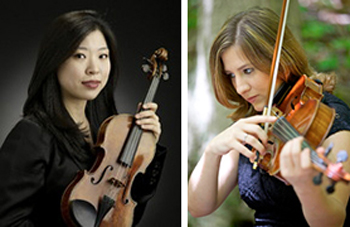By Daniel Hautzinger

In reality, the “dances” concerned are so inventive and stylized that the only vestige of the ballroom is the forms and a certain attention to rhythm. Lee began with Bach’s Partita No. 2 in d, a collection of five Baroque dance forms. Of these, the jauntiest is the “Gigue,” in which Lee brought out a strong pulse, allowing skittering notes to fall into larger, more comprehensible groupings.
The slow movements of the Partita target the heart rather than the feet, such emotional tour-de-forces that they are. Lee was engrossing in the “Sarabande,” gorgeously rendering the two moments when a single line reaches up from double-stopped chords. The epic “Chaconne,” longer than the other four movements combined, received a performance worthy of its greatness. Lee drove through each variation with an inexorable sense of direction, her brisk tempo sweeping the audience through each affecting twist and turn of the music, especially in the fast and virtuosic variations.
Bach’s masterpiece then dovetailed into a very different chaconne, Salonen’s “Lachen Verlernt” (“Laughing unlearnt”), which takes its title from Schoenberg’s Pierrot Lunaire. Fittingly for a piece by Salonen, who recently appeared in an ad campaign for Apple’s iPad, Lee used a pedal-operated tablet for a score. Her tone sharpened to a fine-tipped knife in stratospheric lines and blistering scales for a violently exciting performance.
Like “Lachen Verlernt”, Eugène Ysaÿe’s Violin Sonata Op. 27, No. 4 nominally contains dance forms, but the connection to those original forms is thin. The “Allemande” is slower than would be expected, and unlike Bach’s “Sarabande,” Ysaÿe’s is calm, with a theme in pizzicato chords. Ironically, the most dancelike movement is the one that lacks a dance form, the “Finale.” Lee invigoratingly sped through its rapid-fire melodies and played the quasi-Baroque middle section with refinement and grace.
Astor Piazzolla’s six Tango Etudes, of which Lee performed three, were the closest in spirit to their dance influences. She inflected the bombastic No. 3 and lovesick No. 4 with romantic vibrato and delighted in the vivacious No. 6.
Altered versions of Baroque music and its dance forms returned in the final piece, Johan Halvorsen’s “Sarabande con variazioni” in g for violin and viola. Lee was joined by fellow Cleveland Orchestra member Joanna Patterson Zakany for this Romantic set of variations on a nobly lamenting theme of Handel. (The piece is effectively another chaconne, since it features variations over a repeating harmonic progression with a chaconne-like rhythm.)
Zakany swayed with the rhythm (at last, a dance) and added warmth to the duo’s sound, the variation featuring viola especially striking with her bronze tone. Halvorsen indulges in full-blown Romanticism for the last variation, with towering stacks of chords and slashing arpeggios. Lee and Zakany matched his passion for an explosive end to a concert of dances that moved the heart and mind rather than the feet.
Published on ClevelandClassical.com July 11, 2014.
Click here for a printable copy of this article.


